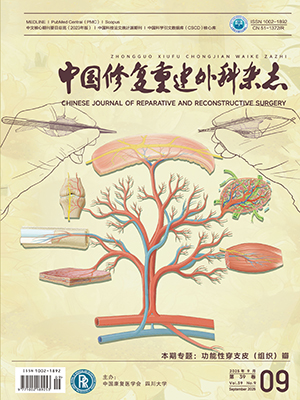OBJECTIVE: To investigate the feasibility of the chitosan-collagen membrane (CCM) as a dermal substitute. METHODS: Fresh bovine tendo calcaneus collagen was dispersed in 0.5 mol/L acetic acid, co-precipitated with chitosan and lyophilized. Dry membranes were cross-linked in 0.05% glutaraldehyde for 24 hours. In vitro its degrading rate was measured by use of collagenase degrading test. The chitosan-collagen membrane was implanted to subcutaneous dorsal sites of SD rats. After implantation, histocompatibility, vascularity and degradation were observed in vivo. RESULTS: The chitosan-collagen membrane was yellowish, translucent, and porous. Pore size ranged 50-250 microns, and collagen fiber bundles were reticular arrangement in the membrane. It had slower degradation than pure collagen membrane by collagenase in vitro. Subcutaneous implantation test showed the minimal inflammation, good histocompatibility and earlier vascularization. The membrane degradation was slower in vivo. Eight weeks after implantation, organized collagen structure was retained. CONCLUSION: The chitosan-collagen membrane has better physical and biological properties, ideal histocompatibility, earlier vascularization and slower degradation. Therefore, It is an optimum substitute for dermal scaffold.
Citation: WANG Yongsheng,HOU Chunlin,XIAO Shichu,et al.. EXPERIMENTAL STUDY ON PREPARING CHITOSAN-COLLAGEN MATRIX AND SUBCUTANEOUS IMPLANTATION. Chinese Journal of Reparative and Reconstructive Surgery, 2003, 17(3): 233-236. doi: Copy
Copyright © the editorial department of Chinese Journal of Reparative and Reconstructive Surgery of West China Medical Publisher. All rights reserved




